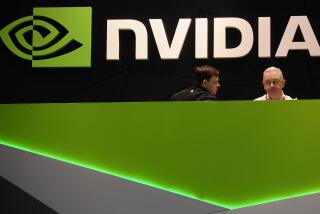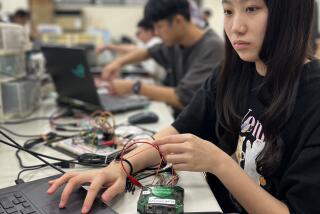U.S., Japanese Firms Find a Common Cause
Pat Weber, head of Texas Instruments’ semiconductor division, was making a routine call on one of his largest customers in the fall of 1987 when the conversation turned to coming technologies. Weber was exploring how TI could efficiently develop the next generation of computer memory chips, and it turned out the customer had similar concerns. A series of discussions began, and they ended one year later with a joint technology development agreement.
The other company was Hitachi, one of a handful of Japanese conglomerates whose relentless drive into high technology has terrified American business and political leaders. Hitachi, in fact, was regarded as a chief villain in the rancorous trade dispute over semiconductor dumping, and it is among the key targets of U.S. Memories, the proposed national chip-building consortium announced June 21. Was Weber concerned about giving aid and comfort to the enemy? “It was not part of the calculation,” he says.
It’s not that TI is peculiarly unpatriotic. Indeed, what’s remarkable about the TI-Hitachi accord is how unremarkable it is. For, despite continued trade frictions and the multifaceted effort to rebuild the U.S. chip industry in the face of the Japanese challenge, silicon smelters on the two sides of the Pacific are collaborating more closely than ever before. And the alliances that have developed in the past several years are more balanced--and likely to last far longer--than the traditional licensing arrangements that some critics have said amount to a giveaway of U.S. technology.
“There’s more of a recognition today that there has to be cooperation,” says Weber. “Fewer and fewer companies can afford to make the investments (in expensive new semiconductor technologies) alone. We see this as a way to strengthen our position and be a better supplier.”
The agreements between U.S. and Japanese companies vary widely in their scope and objectives. The TI-Hitachi accord is limited to joint development of a new generation of memory chips, 16 megabit dynamic random access memories, or DRAMs, that will not be on the market for several years. In contrast, Motorola and Toshiba have a more far-reaching deal, announced in 1987, under which Toshiba has traded its advantages in memory chip design and production technology for Motorola’s expertise in microprocessors, the sophisticated brains at the heart of every computer.
James A. Norling, chief of Motorola’s semiconductor operations, says the relationship with Toshiba, which includes a 50-50 joint venture company in Japan as well as the technology swaps, provides a way for Motorola to rebuild its competence in the memory area. “No matter who you are and how big you are, you can’t be good at everything,” Norling observes. “We decided that if we could find a company that provided a good match for our capabilities, we would both come out better off.”
Both Norling and Weber say they would have been happy to team with an American company. And while some U.S. companies were willing, they couldn’t offer the technological fit that Toshiba and Motorola wanted.
But in some cases, American firms apparently were less than eager to do deals with their compatriots. When Xilinx, a tiny Silicon Valley designer of advanced logic chips called gate arrays, was looking for a “foundry” agreement--essentially a subcontracting arrangement for the manufacture of a semiconductor product--U.S. companies were not much interested, according to Executive Vice President Wes Patterson.
“It would be far simpler to have a local partner,” Patterson says. “But we couldn’t find an American company that was willing to deal with us. We didn’t have enough volume.” Xilinx ultimately formed a partnership with Seiko Epson, a Japanese watch and electronics conglomerate. “This is a good example of the Japanese taking a longer view of things,” Patterson concludes.
Could Aid Economy
More commonly, however, the Japanese are simply in the best position to provide American companies with the manufacturing process expertise and the memory chip capabilities that they need most. “A few years ago, the technology was flowing from the U.S. to Japan,” says Jim Feldhan, vice president of In-Stat Inc., a chip industry research firm. “Now that process has reversed.”
This transfer of technology from Japanese to American firms could have substantial benefits for the U.S. economy. “If there is a real transfer of technology, if American firms learn something, and if they can wean themselves from technological dependence over the long term, then it’s good for the technological infrastructure,” says Jeffrey Hart of the Berkeley Roundtable on the International Economy.
Claude Barfield, director of science and technology policy studies at the American Enterprise Institute, notes that there are “a variety of ways the companies can go about building their capabilities,” including all sorts of alliances and consortiums. He adds that “technology flows worldwide,” and that “techno-nationalist” efforts to exclude foreigners from projects such as the Sematech chip-manufacturing technology consortium are ultimately self-defeating.
In this context, the U.S. Memories venture can be seen as just another strategic alliance in which all the players happen to be American. The purpose of the grouping, which thus far includes IBM and six other leading computer and semiconductor firms, is to share the risk and expense of participating in the difficult computer memory market--the same goal being pursued by TI and Motorola through alliances with the Japanese. “In terms of rebuilding America’s capabilities, a stronger Motorola is part of that,” Norling says, as is U.S. Memories, which he applauds.
Both Stand to Gain
But U.S firms large and small face a major management challenge in getting their share of technology out of relationships with Japanese companies and avoiding some of the one-way transfers of the past. The situation of VLSI Technology is in some ways typical. A middle-sized Silicon Valley firm that specializes in the production of ASICs, or application specific integrated circuits, VLSI teamed with Hitachi in mid-1988 in an effort to gain production process expertise. In return, VLSI is giving Hitachi access to its leading edge ASIC design tools, which Hitachi will use to create its own proprietary circuits.
“We both have a lot to gain over an extended period of time,” maintains VLSI’s chairman and chief executive, Alfred J. Stein. “This is not a short-term thing where they get our technology and then run us out of business. We will end up much stronger than if we had never done it.”
Stein says there is “a whole different outlook” on alliances and joint ventures than there was just a few years ago. Traditionally, links between competitors in the semiconductor industry involved either straight licensing of technology in exchange for a fee, or so-called second source agreements, in which the inventor of a chip would give another company the right to manufacturer and sell a product on the theory that the computer manufacturers that were the customers wanted to have more than one supplier.
“We always hoped that the second-source manufacturer couldn’t really make the product,” Stein jokes. “Our old second-source agreements were really along the lines of selling technology, and the outcome was not generally what we wanted,” adds Norling, in reference to a defunct deal with Hitachi. “There’s a good way to do partnerships and a bad way.”
Michael Boss, an industry analyst at the market research firm Dataquest, characterizes the changing nature of alliance activity as a shift from tactical to strategic links. Companies that had once sought simple short-term advantages--such as more money, more quickly--were now looking at how they would be positioned over the long haul in the extremely competitive and capital intensive semiconductor world.
Lack Market Share
Interestingly, American firms may be getting all the benefits of strategic alliances except the one that was an early incentive for them in the first place: access to the Japanese market. Officials at Advanced Micro Devices (which has an alliance with Sony), VLSI Technology and Motorola all indicated that efforts to increase sales in Japan were moving slowly, and the U.S. industry’s share of the Japanese market has barely budged beyond its traditional 10% level.
The Japanese companies that have not engaged in major alliances, meanwhile, are pouring billions of dollars into U.S. semiconductor manufacturing facilities. And some economists believe that that, too, can be good for the country. Robert B. Reich of Harvard University says the issue is not corporate profitability but the division of labor among different countries. The question Reich asks is: “How do national objectives fit with the multinational strategies of these companies?”
Projects that lead to the more sophisticated development and production functions taking place in the United States will be good for the nation in the long term, according to Reich. By this standard, both U.S. Memories and the U.S.-Japan alliances might fit the bill.
THE CHIP CONNECTION
Equipment Manufacturing Ties
U.S. Japanese Began company company (year) Intel Matsushita 1988 Mitsubishi 1987 Motorola Toshiba 1987 Nat. Semi Mitsubishi 1987 Powerex Mitsubishi 1988 Signetics Matsushita 1988 Tex. Instr. Mitsubishi 1988 Weitech Matsushita 1988 (N/A) Fujitsu 1987
Technical Exchanges
U.S. Japanese Began company company (year) Intel Fujitsu 1986 LSI Logic Sharp 1987 MIPS NEC 1989 AMD Sony 1987 Motorola Toshiba 1987 Tex. Instr. Hitachi 1989 Sony 1988 VLSI Tech Sanyo 1988 VTI Hitachi 1988
Joint Venture
U.S. Japanese Began company company (year) Motorola Toshiba 1988
Product and Production Sharing
U.S. Japanese Began company company (year) Intel Mitsubishi 1987 Nat. Semi Mitsubishi 1988 Motorola Fujitsu 1987 Toshiba 1987 Mitsubishi 1987 Tex. Instr. Fujitsu 1987 NEC 1988 Mitsubishi 1986 Other Fujitsu 1988
Source: In-Stat Inc.
GLOSSARY OF HIGH-TECH TERMS ASIC--Application Specific Integrated Circuit. Semiconductors specifically designed to suit an electronics manufacturer’s particular requirement, as opposed to a DRAM or microcontroller, which is a general-purpose part.
DRAM--Dynamic Random Access Memory (chip). The most abundant type of memory chip.
EPROM--Erasable programmable read-only memory chips (ultraviolet-erasable).
Gate array--An ASIC that is customized through one or more layers of metal interconnect.
Microprocessor--The basic arithmetic, logic, and control elements required for processing (generally contained on one integrated circuit chip). Widely used as control devices for microcomputers, household appliances, business machines, toys, etc.
RISC--Reduced Instruction Set Computer (chip). A type of microprocessor that processes programs much more quickly because it uses a smaller set of instructions.
SRAM--Static Random Access Memory chips. SRAMs do not lose their contents as long as power to the computer is on. Once the computer puts a value into a static memory location, it remains there.
Source: Semiconductor Industry Assn.
More to Read
Inside the business of entertainment
The Wide Shot brings you news, analysis and insights on everything from streaming wars to production — and what it all means for the future.
You may occasionally receive promotional content from the Los Angeles Times.










